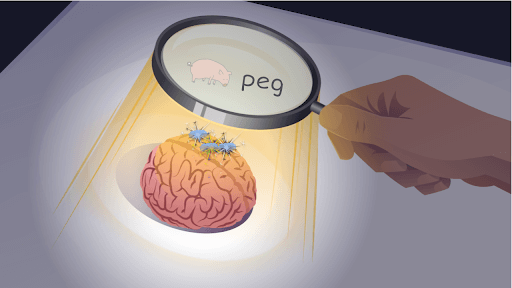How to Do a Spelling Analysis
Written by Sandie Barrie Blackley, Speech-Language Pathologist
Published on May 4, 2022
Spelling analysis is a powerful tool for helping students master decoding and spelling. Spelling patterns are like little lights illuminating how the student’s brain has processed a word. A brief conversation about a spelling error can light the way to more accurate and automatic reading and writing.

Spelling Analysis in Practice
To use spelling analysis you need to know how the English spelling system works. For example:
- English has 44 speech sounds spelled with 26 letters and letter combinations.
- English spelling uses both phonics (how letters represent speech sounds) and morphology (how word parts combine to represent meaning), but it prioritizes the consistent spelling of meaningful word parts over their pronunciation. For example, the past tense suffix is pronounced three ways (“d” as in filled; “t” as in backed; “uhd” as in lifted), but it is always spelled -ed.
- English spelling operates on predictable patterns, but most of the patterns are not obvious.
- There are sound-based patterns, such as the pattern that predicts that -a- will be pronounced “aw” when it comes after a “w” sound (as in want).
- There are letter-based patterns, such as the pattern that predicts that the consonant sound “k” will be spelled -c- when it comes before the letters -a-, -o-, or -u- (as in cut) and the pattern that predicts when the -e- will be dropped when adding a suffix (as in making).
- English has a lot of homophones (words that are pronounced alike but that have different meanings), like tax & tacks; meet & meat; which & witch; to, too & two.
- English has a number of heteronyms (words that are spelled alike but that have different pronunciations and meanings), like tear meaning “rip” and tear meaning “liquid from the eye.”
- Letter case is part of spelling, so capitalization matters, like in holly & Holly.
Using Conversation to Correct Spelling Errors
Conversation (sometimes referred to as Socratic dialogue), used in conjunction with spelling analysis, can be a powerful and memorable way to correct a student’s spelling errors.
In the example illustrated above, in which a student misspelled the word pig as peg, the conversation might go like this:
- Adult: (The adult realizes that the child’s error is related to a letter-sound confusion so asks a question to clarify that.) There is one letter-sound that is spelled wrong. Let me hear you isolate the three sounds in the word pig.
- Student: “p” “ih” “g”
- Adult: Great! Now just pronounce the middle sound, the vowel.
- Student: “ih”….. Oh! I should have spelled it -i-!
- Adult: Exactly! Great job spotting your error! Let’s fix it.
An example of a more advanced student who misspelled the word defrosting as dufrosting, the conversation might go like this:
- Adult: (The adult realizes that the child’s error is related to over-extension of phonics. The prefix is spelled de-, but it is pronounced “duh”, so the adult asks a clarifying question.) There is a spelling error here. Let’s see if you can spot it. What is the base part in the word defrosting?
- Student: frost
- Adult: Right! So, what are the other word parts?
- Student: Well, the suffix is -ing. And the prefix is…..Oh! It is spelled de-!
- Adult: Yes! Exactly How did you figure that out?
- Student: Because defrost means to remove frost.
- Adult: Super! The prefix sounds like “duh” but it is spelled de-, not du-. It was in our lesson this week, in words like depart and delay. Do you remember what the prefix de- means?
- Student: I think it means…like off or remove?
- Adult: You nailed it! One more question. Why is the de- prefix pronounced “duh”?
- Student: Because…it is… weak and mushy …uh….a schwa sound?!
- Adult: Very impressive!
How Lexercise Can Help
If you are a parent whose child is struggling with reading and/or spelling, consider Lexercise Professional Therapy, with a therapist who can use spelling analysis and error correction adjusted to your child’s current level and specific patterns.
If you’d like to learn more about structured literacy, check out our Professional Education Courses and make sure you subscribe to our blog below for information and resources on literacy and dyslexia.
Finally, here is a rationale for evaluation and teaching of spelling by D.K. Reed (2012), funded by the US Department of Education. It includes a chart of (basic) spelling expectations by grade according to the Common Core State Standards. Why Teach Spelling?
Improve Your Child’s Reading
Learn more about Lexercise today.
Schedule a FREE
15-minute consultation



